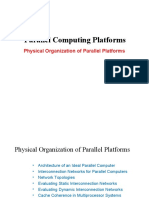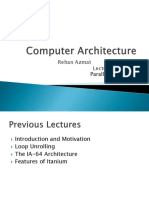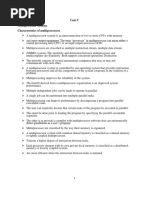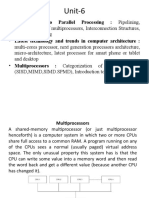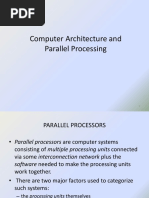0 ratings0% found this document useful (0 votes)
39 viewsInterconnection Networks
Some paper on interconnection networks describing common solutions in multiprocessor architectures.
Uploaded by
Стефан СавићCopyright
© © All Rights Reserved
Available Formats
Download as PDF or read online on Scribd
0 ratings0% found this document useful (0 votes)
39 viewsInterconnection Networks
Some paper on interconnection networks describing common solutions in multiprocessor architectures.
Uploaded by
Стефан СавићCopyright
© © All Rights Reserved
Available Formats
Download as PDF or read online on Scribd
You are on page 1/ 40
interconnection
Networks
Howard Jay Siegel
William Tsun-yuk Hsu
6.1. Introduction
Many tasks require the computational power made possible by parallel pro-
cessing. The demand for fast computation is usually due to a desire for real-
time response and/or the need to process immense data sets. These types
of tasks include acrodynamic simulations, air traffic control, chemical re-
action simulations, seismic data processing, satellite-collected imagery anal-
ysis, missile guidance, ballistic missile defense, weather forecasting, map
making, robot vision, and speech understanding. Systems comprising a mul-
titude of tightly coupled, cooperating processors can help provide the com-
putational performance required by these tasks. STARAN (7) and MPP (8)
are examples of existing systems with 2° and 2'* simple processors, re-
Some of the material in this chapter is summarized from Interconnection Networks for
Large-Scale Parallel Processing, by H. J. Siegel, Lexington Books, D. C. Heath and Company,
Lexington, MA, copyright 1985. This project was supported by the Rome Air Development
Center, under contract number F30602-83-K-01 19, the Institute for Defense Analyses Super-
computing Research Center under contract number MDA 904-85-C-5027, and the Purdue Re-
search Foundation David Ross Grant 1985/86 number 0857.
225
226 Part Il/Topics in Multiprocessing
spectively. Ultracomputer (28) is a proposed design for a system consisting
of 2'? complex processors. This chapter examines methods to provide com-
munications among the processors and memories of such large-scale parallel/
distributed systems.
Two models of interprocessor communication networks were intro-
duced in Chapter 5. The processor-to-memory model assumes N processors
on one side of a bidirectional network and N memory modules on the other
side. It is also possible to organize processors and memory modules into
processor/memory pairs or processing elements (PEs). In the PE-to-PE
model, PE i is connected to input i and output i of a unidirectional inter-
connection network. In this chapter, the PE-to-PE model will be used; how-
ever, the material presented is also applicable to processor-to-memory
systems.
The taxonomy originated by Flynn (26) to describe parallel processors
has already been described in Chapter 5. Two of the modes of parallelism
described by Flynn are the SIMD and MIMD modes. SIMD stands for single
instruction stream-multiple data stream. An SIMD machine may consist of
N PEs, an interconnection network that provides communications between.
PEs, and a single control unit. The control unit broadcasts instructions to
all the PEs, and all enabled PEs execute the same instructions simultane-
ously, hence forming a single instruction stream. Each PE operates on its
own data from its memory. Hence, there are multiple data streams. MIMD
stands for multiple instruction stream—multiple data stream. An MIMD ma-
chine may consist of N PEs linked by an interconnection network. Each PE
stores and executes its own instructions and operates on its own data. There-
fore, there are multiple instruction streams and multiple data streams. In
addition, there are MSIMD (multiple-SIMD) machines and partitionable
SIMD/MIMD machines. MSIMD machines are systems that can be recon-
figured into a number of smaller, independent SIMD machines. Partitionable
SIMD/MIMD machines can be partitioned into smaller virtual machines
working in SIMD or MIMD mode. These have been covered in Chapter 5.
The task of interconnecting N processors and N memory modules,
where N may be in the range 2° to 2'°, is a nontrivial one. The interconnection
scheme must provide fast and flexible communications without unreasonable
cost. A single shared bus, as shown in Figure 6.1, is not sufficient because
it is often desirable to allow all processors to send data to other processors
simultaneously (e.g., from processor i to processor i — 1, 1 =i < N). The
Figure 6.1 A single shared bus used to
provide communications for N devices.
Interconnection Networks 227
Figure 6.2 A completely connected system for N = 8.
ideal situation would be to link directly each processor ta every other pro-
cessor so that the system is completely connected. This is shown for N =
8 in Figure 6.2, where one could assume, for example, that each node is a
processor with its own memory. Unfortunately, this is highly impractical
for large N because it requires N — 1 unidirectional lines for each processor.
For example, if N = 2°, then 2° x (2° — 1) = 261,632 links would be needed.
An alternative interconnection scheme that allows all processors to
communicate simultaneously is the crossbar switch, shown in Figure 6.3.
In this example, the processors communicate through the memories. The
network can be viewed as a set of intersecting lines, where interconnections
between processors and memories are specified by the crosspoint switches
at each line intersection (75). The difficulty with crossbar networks is that
168
proc.
i
[
‘crosspoint
switch
proc.
New
Figure 6.3 A crossbar switch connecting N processors to N memories.
228 Part I/Topics in Multiprocessing
the cost of the network (the number of crosspoint switches) grows with N?,
which, given current technology, makes it infeasible for large systems.
In order to solve the problem of providing fast, efficient communica-
tions at a reasonable cost, many different networks between the extremes
of the single bus and the completely connected scheme have been proposed
in the literature. No single network is generally considered ‘‘best.”” The cost-
effectiveness of a particular network design depends on such factors as the
computational tasks for which it will be used, the desired speed of inter-
processor data transfers, the actual hardware implementation of the net-
work, the number of processors in the system, and any cost constraints on
the construction. A variety of networks that have been proposed are over-
viewed in numerous survey articles and books, e.g., (4, 12, 21, 32, 34, 37,
42, 62, 74, 81).
This chapter is a study of an important collection of network designs
that can be used to support large scale parallelism—i.e., these networks can
provide the communications needed in a parallel processing system con-
sisting of a large number of processors (¢.g., 2° to 2'6) that are working
together to perform a single overall task. Many of these networks can be
used in dynamically reconfigurable machines that can perform independent
multiple tasks, where each task is processed using parallelism.
The networks examined here are based on the ‘‘Shuffle-Exchange,””
“Cube,” ‘‘PM2I’’ (plus-minus 2‘), and “Illiac’* (nearest neighbor) inter-
connection patterns. These networks and their single stage implementations
are explored in Section 6.2. Section 6.3 is a study of the multistage Cube/
Shuffle-Exchange class of networks. The Generalized Cube network will be
discussed as an example of this type of network. A fault-tolerant yersion of
the Generalized Cube network, called the Extra Stage Cube network, is the
subject of Section 6.4. Data manipulator type networks, which are multistage
implementations of the PM2I connection patterns, will be discussed in Sec-
tion 6.5.
6.2. Interconnection Functions and Single Stage
Networks
6.2.1. Introduction
Assume a parallel system with N = 2” PEs, numbered (addressed) from 0
to N — 1. An interconnection network can be described by a set of inter-
connection functions. Each interconnection function is a bijection (permu-
tation) on the set of PE addresses. Interconnection functions represent inter-
PE data transfers using mathematical mappings. When an interconnection
function f is executed, PE i sends data to PE f(i). If a system is operating
in SIMD mode, this means that every PE sends data to exactly one PE, and
every PE receives data from exactly one PE (assuming all PEs are active).
Interconnection Networks 229
Otherwise, the data transfer from PE i to PE f(i) may occur only for a subset
of the PEs in the system.
Four types of interconnection networks will be discussed: the Cube,
the Iliac, the PM2I, and the Shuffle-Exchange. Interconnection networks
can be constructed from a single stage of switches or multiple stages of
switches. In a single-stage network, data items may have to be passed
through the switches severa! times before reaching their final destinations.
In a multistage network, generally one pass through the multiple (usually
m) stages of switches is sufficient to transfer the data items to their final
destinations.
An important consideration in the selection of an interconnection net-
work for a system is the partitionability of the network. The partitionability
of an interconnection network is the ability to divide the network into in-
dependent subnetworks of different sizes (60). Each subnetwork of size N’
< N must have all of the interconnection capabilities of a complete network
of that same type built to be of size N'. Multiple-SIMD systems use par-
titionable interconnection networks to dynamically reconfigure the system
into independent SIMD machines of varying sizes. The multiple-SIMD
model will be used as a framework for the partitioning analyses in this chap-
ter. However, the results can be used to partition MIMD and partitionable
SIMD/MIMD machines also.
The subject of this section is the single-stage implementation of the
Cube, Iliac, PM2I, and Shuffle-Exchange interconnection networks. Each
of these networks will be defined, and examples of their operation in both
the SIMD and MIMD modes of parallelism will be given. The partitionability
of these single stage networks will also be discussed. Further information
about these topics is in (59-61, 69).
The following notation-will be used: let the binary representation of an
arbitrary PE address P be pm—1Pm—2 « - » P1Po, let p; be the complement of
p:, and let the integer n be the square root of N. It is assumed throughout
this chapter that —7 modulo N = N — j modulo N, for j > 0—e.g., —4
modulo 16 = 12 modulo 16.
6.2.2. The Cube Network
The Cube network consists of m interconnection functions defined by:
cube(Pm—1 °° Pir 1PiPi-1 *** Po) = Pm—1°** Pix1PiPi-1 *"* Po
for 0 4. Because P + 2”~!
= P — 2”~! modulo N, PM2n—1 and PM2—¢,—» are equivalent. Figure
6.7 shows the PM2.,; interconnections for N = 8; PM2_,; is the same as
PM2..; except the direction is reversed. This network is called the Plus—
Minus 2' because, in terms of mapping source addresses to destinations, it
Figure 6.6 Partitioning a size-cight Cube network. (A) Physical cube; (logical
cubes). (B) Physical cube, (logical cubes).
Interconnection Networks 233
ic 0 oe o 7,
Figure 6.7 PM2I network for N = 8. (A) PM2+0 connections. (B) PM2.1
connections. (C) PM2,2 connections.
can add or subtract 2‘ from the PE addresses—i.e., it allows PE P to send
data to any one of PE P + 2! or PE P — 2', arithmetic modulo N, 0 si <
m.
A network similar to the PM21 is used in the “Novel Multiprocessor
Array’? (50) and is included in the network of the Omen computer (31), The
interconnection network of the SIMDA machine is similar in concept to that
of the PM2I (78). The data manipulator (20), ADM (66), IADM (63), and
gamma (52) multistage networks are based on the PM21 connection pattern.
Various properties of the single-stage PM2I network are discussed in (24,
56, 58, 67, 70).
Network control in SIMD made can be achieved by means of a system
control unit, as in the Cube network. Suppose the PM2I network is imple-
mented in the hardware, and a cube, transfer is needed. Mathematically,
this means that the i-th bit of each PE address would have to be comple-
mented using PM2I functions—i.e., data needs to be moved from PE P to
PE cube,(P), 0 = P
You might also like
- 1 Module 1 Introduction To Multiprocessors September 29 2024No ratings yet1 Module 1 Introduction To Multiprocessors September 29 202429 pages
- Parallel Programming Platforms (Part 1) : CSE3057Y Parallel and Distributed SystemsNo ratings yetParallel Programming Platforms (Part 1) : CSE3057Y Parallel and Distributed Systems38 pages
- 2.radmi 2013 Vol 2 MultiprocessorinterconnectionnetworksNo ratings yet2.radmi 2013 Vol 2 Multiprocessorinterconnectionnetworks8 pages
- Multiprocessor Architecture and ProgrammingNo ratings yetMultiprocessor Architecture and Programming20 pages
- Unit 3 Interconnection Network: Structure Page NosNo ratings yetUnit 3 Interconnection Network: Structure Page Nos18 pages
- Interconnection Networks: Crossbar Switch, Which Can Simultaneously Connect Any Set ofNo ratings yetInterconnection Networks: Crossbar Switch, Which Can Simultaneously Connect Any Set of11 pages
- Interconnection Networks: Crossbar Switch, Which Can Simultaneously Connect Any Set ofNo ratings yetInterconnection Networks: Crossbar Switch, Which Can Simultaneously Connect Any Set of11 pages
- Multiprocessors Interconnection NetworksNo ratings yetMultiprocessors Interconnection Networks32 pages
- Lecture5 (Share Memory" According To Connection)No ratings yetLecture5 (Share Memory" According To Connection)9 pages
- Lecture 5 Network Topologies for Parallel Architectures - UpdatedNo ratings yetLecture 5 Network Topologies for Parallel Architectures - Updated46 pages
- Lecture 4 Network Topologies For Parallel ArchitectureNo ratings yetLecture 4 Network Topologies For Parallel Architecture34 pages
- B.tech CS S8 High Performance Computing Module Notes Module 3100% (1)B.tech CS S8 High Performance Computing Module Notes Module 328 pages
- Parallel Processors: Session 5 Interconnection NetworksNo ratings yetParallel Processors: Session 5 Interconnection Networks48 pages
- Lecture 3.2.4 (Various Interconnection Networks)No ratings yetLecture 3.2.4 (Various Interconnection Networks)5 pages
- Unit - I - Chapter - 1 - Notes-Distributed SystemsNo ratings yetUnit - I - Chapter - 1 - Notes-Distributed Systems14 pages
- Lecture-27 Interconnection Networks+chapter-5 Slides-Version-2No ratings yetLecture-27 Interconnection Networks+chapter-5 Slides-Version-270 pages
- Parallel and Distributed Computing Research PaperNo ratings yetParallel and Distributed Computing Research Paper8 pages
- Computer Architecture and Parallel ProcessingNo ratings yetComputer Architecture and Parallel Processing29 pages
- @vtucode - in 21CS643 Module 4 2021 SchemeNo ratings yet@vtucode - in 21CS643 Module 4 2021 Scheme189 pages
- Multistage Interconnection Network For Mpsoc: Performances Study and Prototyping On FpgaNo ratings yetMultistage Interconnection Network For Mpsoc: Performances Study and Prototyping On Fpga6 pages
- 1 Module 1 Introduction To Multiprocessors September 29 20241 Module 1 Introduction To Multiprocessors September 29 2024
- Parallel Programming Platforms (Part 1) : CSE3057Y Parallel and Distributed SystemsParallel Programming Platforms (Part 1) : CSE3057Y Parallel and Distributed Systems
- 2.radmi 2013 Vol 2 Multiprocessorinterconnectionnetworks2.radmi 2013 Vol 2 Multiprocessorinterconnectionnetworks
- Unit 3 Interconnection Network: Structure Page NosUnit 3 Interconnection Network: Structure Page Nos
- Interconnection Networks: Crossbar Switch, Which Can Simultaneously Connect Any Set ofInterconnection Networks: Crossbar Switch, Which Can Simultaneously Connect Any Set of
- Interconnection Networks: Crossbar Switch, Which Can Simultaneously Connect Any Set ofInterconnection Networks: Crossbar Switch, Which Can Simultaneously Connect Any Set of
- Lecture 5 Network Topologies for Parallel Architectures - UpdatedLecture 5 Network Topologies for Parallel Architectures - Updated
- Lecture 4 Network Topologies For Parallel ArchitectureLecture 4 Network Topologies For Parallel Architecture
- B.tech CS S8 High Performance Computing Module Notes Module 3B.tech CS S8 High Performance Computing Module Notes Module 3
- Parallel Processors: Session 5 Interconnection NetworksParallel Processors: Session 5 Interconnection Networks
- Unit - I - Chapter - 1 - Notes-Distributed SystemsUnit - I - Chapter - 1 - Notes-Distributed Systems
- Lecture-27 Interconnection Networks+chapter-5 Slides-Version-2Lecture-27 Interconnection Networks+chapter-5 Slides-Version-2
- Multistage Interconnection Network For Mpsoc: Performances Study and Prototyping On FpgaMultistage Interconnection Network For Mpsoc: Performances Study and Prototyping On Fpga














